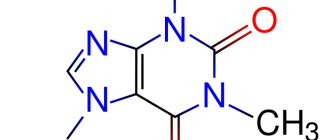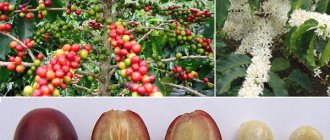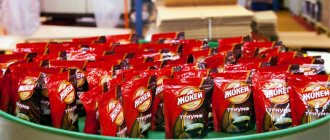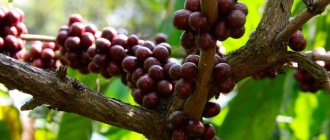A little history
The first mention of the tonic properties of coffee dates back to 850. Several more centuries had to pass before coffee acquired the appearance and taste we are accustomed to.
The first to taste the taste of coffee were the Yemenis, who brewed a very unique drink from raw beans - geshir. In Ethiopia, nothing was brewed from coffee beans. However, knowing about the tonic properties of coffee fruits, they made invigorating chewing balls. Later, this specific use of coffee beans spread to most Arab countries.
Only starting from the 12th century did people begin to brew a drink vaguely reminiscent of what is commonly called coffee. At first the coffee beans were simply dried and ground, and then they decided to roast them first and then grind them.
The first wild Coffee trees were discovered in Ethiopia. On the Arabian Peninsula they began to be planted in gardens and harvested.
Coffee tree seedlings came to France only in the 18th century. And the first plantation of this plant appeared on Martinique, a small island in the Caribbean Sea.
Production scheme
The quality of the finished product largely depends on the primary processing of coffee fruits. Processing consists of two main operations: separating seeds from fruit pulp and shells and drying.
The picked coffee is transported to farms where the fruit is first either sifted or washed with water to remove leaves, unripe fruit, stones, sand and other impurities. But this is only preliminary cleaning. Further processing of coffee fruits is carried out using two methods:
wet and dry coffee processing. Wet processing contains the following stages: cleaning; swelling; removing fruit pulp; fermentation; washing; drying; removing the husk. Dry coffee processing: sorting and sifting; drying; removing pulp; cleaning.
In dry coffee processing, which is used primarily in Brazil and West Africa, the coffee beans are poured onto special drying areas. The grains are dried there in the sun for two to three weeks. In this case, the coffee is constantly mixed using various devices. To protect coffee beans from heat and morning dew, coffee areas are covered with awnings at night. In some climatic zones, part of the crop is dried using special machines with hot air. At the same time, the time for such processing is reduced to two to four days. Once the pulp is completely dry, you can hear the grains inside the fruit “ringing” if you shake them. In drum units, the coffee fruits are broken and the beans are cleaned of dried pulp, covering shells and silvery film. The coffee is then cleaned and sorted by size. The best beans are then selected manually or electronically in modern facilities.
Most high-quality coffees are processed using the rinsing process. This applies to most Central American coffees, Colombian and Mexican coffees, as well as coffees from Kenya and Tanzania. This type of coffee is also called “washed”. The coffee beans are first poured into large containers, where they are left overnight to swell. In special machines, most of the fruit pulp is then removed. Coffee fruits, in which the pulp has not yet separated from the beans, are placed in special drum units to undergo further fermentation processing. After fermentation, the fruit separates the pulp from the grains and frees itself from the covering shell. At the same time, the processes occurring in coffee beans during fermentation significantly improve the taste of coffee. This process takes about a day. Next, the grains are finally washed and dried, usually in the sun, during which the final separation of the covering shell from the grain occurs. Then, in a special installation, the grains are cleaned from the shell and silvery film. Cleaned grains are sorted
If there are only two main types of industrial coffee trees, then where does such a variety of varieties come from? Coffee brewed from Robusta has a significant strength and a rough coffee aroma. Arabica coffee has an intense, complex aroma reminiscent of flowers, fruits, honey, and chocolate. As a rule, the consumer is offered not one type of coffee in its pure form, but a mixture of several varieties. Mixing varieties has a very important goal - to create the desired and very specific taste and aroma of coffee. Mixing is an art that is based not only on knowledge and experience, but also on intuition. Thus, Arabica and Robusta, mixed in various proportions, give a wide range of tastes and aromas of coffee drinks.
How do coffee beans become coffee for making a drink? Coffee imported from producing countries in its raw form is processed in consumer countries. The most important component of good coffee is, along with the quality of the beans, a competent selection of different varieties for the mixture (bouquet). Each coffee manufacturer strives to create and market its own coffee bouquets. For this purpose, mainly Central and South American Arabica beans are used, mixed with African or Indian coffee varieties. When composing a bouquet, they take into account what drinks will be prepared based on it, for example: coffee with milk, espresso, etc. Arranging a coffee bouquet is a real art. Recognized masters perfectly “know” the smell and taste of each variety and have many years of experience. Various types of coffee from different countries are stored in special containers and mixed using automatic machines directly during the preparation of various bouquets. At the same time, the percentage ratio of the constituent varieties is maintained very accurately. The arranged bouquets are then sent to the frying machine.
Coffee roasting is one of the key operations. Coffee will acquire an aroma, smell and characteristic color already at the roasting stage, subject to a temperature regime of 200 to 250 0C, at which the essential oils contained in the beans evaporate.
A roaster is a very important specialist. The quality of roasting and, as a consequence, the final product largely depends on his professionalism, attention and accuracy. He periodically takes a coffee sample during roasting to monitor the progress and degree of roasting. In addition, he monitors the condition of the grains by eye, as well as with the help of special optical instruments, and compares them with samples of a particular bouquet. All grains should be evenly roasted. Roasters typically roast coffee for 12 to 15 minutes. At large enterprises, the coffee roasting process is even more accelerated and automated; the roasting duration (depending on the bouquet) lasts up to 6 minutes and is controlled electronically. When roasting, coffee loses up to a sixth of its weight, but increases in volume by up to 25%. After roasting, the beans, already dark brown, must be unloaded from the roaster and quickly cooled, otherwise the coffee will continue to “re-roast” under the influence of its own temperature. Tasting freshly roasted coffee requires specialists with a special, heightened sense of smell and taste, who first undergo special training.
Accordingly, after roasting, coffee is either packaged (meaning the sale of coffee beans) or ground (for the sale of ground coffee).
Types of coffee tree
Despite the fact that the genus Coffee has about 100 species, there are only four suitable for obtaining beans from which everyone’s favorite drink is prepared:
- Arabian (Coffea arabica L.), which is commonly called Arabica;
- Congolese (Coffea canephora Pierre ex Froehn), the so-called robusta;
- Liberian (Coffea liberica);
- Excelsa.
Arabica is the most common type of coffee tree. Despite this, Arabica is a capricious crop. It grows in an equatorial climate, at an altitude of up to 2500 meters above sea level. The temperature for comfortable existence and fruiting is 16-240C. The average age of a tree is 50-70 years. For the first 15 years after planting, coffee trees actively bear fruit, after which this process slowly declines. The grain is oblong-oval, with an S-shaped center. Its size depends on the place of cultivation.
Robusta is a shrub that can reach 10m in height. Typically, bushes are docked to 2 m to make it easier for workers to reach the fruits when picking. Unlike Arabica, which grows exclusively in the mountains, Robusta thrives in valleys and at elevated temperatures. The grains are round, large in size, with a smooth center. Robusta is more productive, since ovaries, flowers, and ripening fruits can be observed on one tree. And harvesting takes place 4 times a year.
Liberian coffee is a type of coffee tree that, due to its extreme capriciousness, is not grown on an industrial scale. This coffee is exported extremely rarely. And it is never consumed in its pure form, as it has a sharp, even bitter taste.
Excelsa is the rarest type of coffee. It is also called “Tall”, since the tree can grow above 20m. Like Liberica, Excelsa is unlikely to be found in its pure form, but only because it is very expensive.
Chemical composition, nutritional value of coffee
Coffee has a complex chemical composition. It contains approximately two thousand chemicals that together give it its distinctive aroma and taste.
Raw coffee beans contain fats, proteins, water, mineral salts, mycotoxins, and various water-soluble and insoluble substances. Roasted coffee beans lose most of their water (its content decreases from 11% to 3%), and their chemical composition changes depending on the degree and duration of roasting. It represents a wide range of components.
The moisture content of raw coffee plays an important role in its export and import, because All calculations are made based on the moisture content. Raw coffee beans belong to the group of products with a capillary-porous colloidal structure. The water content in raw coffee beans according to the standard adopted by the International Coffee Organization should be 12±1%. But depending on storage and transportation conditions, the moisture content of raw coffee ranges from 9-14%.
Raw coffee beans, calculated on a dry matter basis, contain 32-36% extractives, which are stable for seven years or more under normal storage conditions. The dry matter of raw coffee contains the following main components: alkaloids such as caffeine - 0.7-2.5%. This substance is colorless and odorless; in aqueous solution it gives a bitter taste. The amount of caffeine in beans varies greatly depending on the type of coffee. Caffeine is found in varying amounts in more than a hundred plants, but only coffee fruits, cocoa, guarana and tea leaves contain quite a lot of it. The degree of roasting of the beans also affects the caffeine content of the drink, with more roasted beans, such as for espresso coffee, producing less caffeine. The caffeine content of beans plays a very important role in assessing the quality of raw materials and establishing technical requirements for them. It should be remembered that caffeine, although it has a bitter taste, nevertheless has almost no effect on the taste of coffee. Therefore, it is a big misconception to associate the bitterness of coffee with the presence of caffeine in it. Bitter coffee does not mean strong at all, and vice versa - strong means bitter. In addition to caffeine, coffee beans contain another alkaloid - trigonelline. It is highly soluble in water, but is thermally unstable. When processing coffee beans, it is easily converted into nicotinic acid (vitamin PP). Unlike caffeine, it does not excite and does not have a narcotic effect, but it is involved in the formation of the taste and aroma of roasted coffee. It also contains alkaloids such as theobromine (1.5-2.5 mg%) and theophylline (1-4 mg%). It is worth mentioning a substance that is very complex in composition - kafeol. Including almost two and a half hundred components, it is the carrier of a characteristic coffee aroma.
The bitter taste is imparted to the coffee drink by complex organic substances - tannins. To neutralize them, milk or cream is added to coffee. They bind tannins and the drink loses its bitterness. Tannin content in raw coffee beans varies from 3.6 to 7.7%. During the roasting process, the amount of tannin decreases sharply and 0.5-1% remains in the finished product. A decrease in tannin during roasting is not considered a negative factor, since it contributes to the formation of the taste and color of coffee, however, with excessive heating, the tannin is completely decomposed. The hollow or “flat” taste of roasted coffee can sometimes be attributed to the disappearance of tannin.
Protein substances are contained in coffee in amounts from 9 to 19.2%; fat (lipids) - 9.4-18% (it almost completely remains in the dry residue and does not pass into the finished drink); sucrose - 4.2-11.8% (soluble carbohydrates - sucrose, fructose and galactose in the structure of roasted coffee beans occupy from 25% to 28% of all soluble components); monosaccharides - 0.17-0.65%; fiber - 32.5-33.5%; pentosans - 5-7%; tannins - 8.7-11.9%; minerals - 3.7-4.5%.
Carbohydrates account for 50-60% of the total mass of raw coffee beans. During the roasting process, profound changes occur in the composition of the carbohydrate complex of coffee. Sucrose almost completely disappears, leaving 0.56%. At the beginning of frying, the monosaccharide content drops sharply, but by the end of the process it increases significantly. Fluctuations in the composition and quantity of monosaccharides in coffee during its heat treatment are explained by the consumption of some of them for the processes of caramelization and melanoid formation, and then an increase in their concentration due to the hydrolysis of fiber, pentoses and other polysaccharides.
Raw coffee beans contain minerals such as: potassium, magnesium, calcium, sodium, iron, manganese, rubidium, zinc, copper, strontium, as well as traces of chromium, vanadium, barium, nickel, cobalt, lead, molybdenum, titanium and cadmium The content of individual mineral elements depends on the type of coffee, the growing area, the processing method, the type of mineral fertilizers applied to the soil, as well as the plant protection products used. During coffee roasting, the mineral content increases to 5-7%, which is associated with large losses of dry matter.
Coffee beans contain more than three dozen different organic acids, including organic acids such as: citric acid - 0.3%, malic acid - 0.3%, tartaric acid - 0.4%, oxalic acid - 0.05%, caffeic acid - 0 .2%, chlorogenic - 4-10.9% - deserves special attention. Chlorogenic acids include about 10 compounds found in coffee, and similar compounds are found in other plants. Even though the coffee bean loses 60% of it during roasting, the remainder is still enough to give the coffee a slightly astringent flavor. In terms of the content of chlorogenic acid, coffee beans are a unique product, because it is not found in such quantities in any other plants. It stimulates nitrogen metabolism and helps build protein molecules. The role of chlorogenic acids in the formation of coffee color during roasting is important. When heated, chlorogenic acids are destroyed and react with amino acids and proteins to form dark-colored products. Coffee beans also contain acetic, oxalic, and pyruvic acids. More than 350 aromatic substances have been identified in roasted coffee. Essential oils give roasted coffee a special aroma. The phenol products they contain have a certain antiseptic effect. The humidity of raw coffee is 9-12%. Also found in coffee are vitamins and enzymes such as: thiamine (vitamin B1), riboflavin (B2), pantothenoic acid, nicotinic acid (PP), pyridoxine (B6), vitamin B12 and tocopherol (E).
As for coffee as a drink, its nutritional value is as follows: 100 g of sugar-free drink contains: proteins - 0.2 g, fats - 0.6 g, carbohydrates - 0.1 g, calcium - 5 mg, vitamin PP - 0.6 mg, potassium - up to 9 mg, phosphorus - 7 mg, iron - 2 mg.
Coffee has virtually no nutritional value, although it contains protein. A 100-gram cup of the drink provides only 9 kilocalories. However, as a source of minerals, mainly potassium, coffee plays an important role. The importance of coffee is also important as a carrier of vitamins P, necessary for strengthening blood vessels. A cup of coffee contains 20% of the body's daily requirement for this vitamin.
Growing conditions
In order to set up a plantation, it is necessary to select the best grains. Within 2.5 weeks, the grains are germinated in special containers. When future trees reach 5 cm, they are placed in greenhouse conditions, where they spend about a year. As soon as the seedlings reach 30cm, they can be planted in open ground in a permanent place of growth. Typically, coffee trees are planted in even rows to facilitate harvesting. The coffee tree blooms after two years and lasts only a couple of days. Then the petals fall off and fruits are formed, somewhat similar to a cherry berry. Coffee ripening, depending on the variety, can be from 8 to 11 months. One coffee tree or bush can produce from 400g to 5kg of beans.
Harvesting is done either manually or using a machine. Hand-picked grains guarantee that only ripe fruit is removed from the tree. This approach is explained by the fact that coffee beans do not ripen at the same time. This method is called picking. The manual harvesting method is quite labor-intensive and more expensive, but the majority of the entire coffee harvest is harvested this way.
Organizing a business for the production of coffee beans or ground coffee
The main specificity of the market is the ratio of sales of natural and instant coffee. The main requirement of buyers is high quality at a minimal price. You can sell goods not only through specialized and chain stores. Coffee shops, cafes, and restaurants are also ready to accept goods at the appropriate price-quality ratio. It also makes sense to focus on online sales.
There is no need to talk about the seasonality of coffee sales. But for better sales of home-made products, it makes sense to open your own point of sale in the future. The optimal option is considered to be a coffee shop in one format or another, which allows several times to increase the cost of each gram of coffee produced.
Paperwork
To register a small enterprise for roasting and grinding green coffee, it is enough to register LLC. The main OKVED code is 10.83 “Production of tea and coffee.” Considering the high costs of purchasing raw materials and maintaining the enterprise, you can choose the simplified tax system “Income minus expenses”. The production will need to be inspected by Rospotrebnadzor and the Fire Inspectorate.
In Government Decree No. 982 of December 1, 2009 “Unified list of products subject to mandatory certification and Unified list of products, confirmation of conformity of which is carried out in the form of a declaration of conformity,” coffee is defined as a product subject to mandatory declaration of conformity.
The old standard ( now inactive ) for voluntary certification is GOST R 52088-2003. “Naturally roasted coffee. General technical conditions".
Start-up capital
The basic set of equipment largely depends on the planned volumes. To reduce costs, you can buy used.
The only exception is coffee grinders. Given the enormous loads on this unit, if the quality of the parts is not high enough, it will have to be regularly repaired and replaced. The coffee sifting machine can be replaced with a much cheaper unit designed for flour. In total, a basic coffee roasting and grinding line will cost:
| Name | Cost, rub. |
| Roaster KDM VK-3 | 675000 |
| Packaging line KDM SP-500 | 197000 |
| Sifter MP-150 | 27000 |
| Total | 899000 |
Additionally, you can purchase an industrial coffee grinder to expand the range. For example, the NAO-1500 model from KDM with a capacity of up to 30 kg/hour costs 89,000 rubles.
Please note that the shelf life of ground coffee is 14 days. In four-layer paper packaging, it extends up to 6 months. If it has a polymer or metal coating - up to 1 year. You can also purchase a vacuum packaging machine from 35,000 rubles, for example the DZ-260 model from the company Magikon. Coffee can be stored in a vacuum for up to 1.5 years.
To accommodate a workshop you need 20-30 m2. Warehouses for storing raw materials and finished products - 15 m2 each. With a total area of 50,000, the cost of renting the premises is about 20,000 rubles. per month. In general, the required starting capital is:
| Name | Cost, rub. |
| Preparation of documentation, including declaration | For individual entrepreneurs - ≈15000, for LLC - ≈30000 |
| Advertising and website creation | 100000 |
| Equipment | 899000 |
| Rental and renovation of premises | 200000 |
| other expenses | 50000 |
| Total | 1259000 |
If a barcode is needed for packaging, then to obtain an EAN barcode you will need from 15,000 rubles;
Monthly expenses
The average market price for imported green coffee is $3,500 per ton. However, it should be borne in mind that during roasting the grain loses about 20% of its original weight due to moisture evaporation. Therefore, with a production volume of 4 tons/month, 5 tons of raw materials are required. Accordingly, it is necessary to allocate about 1,050,000 rubles for purchases, and an additional 200,000 rubles for packaging and stickers.
Small production requires minimal staff: a roaster and 2 general workers. You can also include in the wage fund the services of specialists to maintain the operation of the site. The entrepreneur is responsible for accounting and concluding contracts. In general, monthly expenses for wages will be:
| Job title | Salary, rub. | Quantity | Salary, rub. |
| Roaster | 40000 | 1 | 40000 |
| Handyman | 20000 | 2 | 40000 |
| IT specialist | 50000 | 1 | 50000 |
| Payroll | 130000 | ||
Another necessary expense item is advertising. To get started, you should prepare a website store in advance to accept applications and first sales. It is also necessary to place advertisements in the media and hang banners. In total, at the first stage you can get by with 100,000 rubles.
Taking into account rental and advertising costs, as well as other associated costs, including packaging, maintaining a coffee roasting and grinding facility will cost:
| Name | Cost, rub. |
| Purchasing green grains | 1050000 |
| Package | 200000 |
| Rent and utilities | 30000 |
| Payroll | 130000 |
| 10000 | |
| other expenses | 20000 |
| Total | 1440000 |
Revenues and profits
At the initial stage, it makes sense to launch production directly to existing orders, at the same time adjusting the degree of grinding. Therefore, in the calculations we will assume that the sales level is 100%. So the monthly income will be:
| Coffee produced, t | 4 |
| Current costs, rub. | 1440000 |
| Cost of 1 ton, rub. | 360000 |
| Average market value, rub. | 800000 |
| Income per month, rub. | 3200000 |
| Profit before tax, rub. | 1760000 |
| Tax (USN 15%), rub. | 264000 |
| Net profit, rub. | 1496000 |
With such volumes, the payback period will be about a month. However, much depends on the success of maintaining high quality products and a competent pricing policy when searching for customers. It can take 6 months before a new brand becomes recognizable, earns regular customers and pays for itself.
Drying coffee beans
Before sending a coffee berry for roasting, it is necessary to clear it of the layers covering the grain. To extract a valuable product, three methods are usually used:
- dry (traditional);
- washed (“wet”, with water);
- honey
The dry method involves laying out coffee on flat wooden surfaces or “African beds” - special mesh frames raised above the ground by about a meter. The berries spend quite a long time there - up to 4 weeks. In order to avoid rotting, the fruits are constantly mixed.
Coffee dried in this way is cheaper and is labeled as Natural, DP, Dry, Dry Processed. Experts call this type of coffee wild, since the beans, having absorbed the sweet taste of the pulp, acquire a specific citrus aroma.
The wet method of extracting grains is much more expensive than the dry method. It is used for coffee cherries collected by picking. First, the fruits are soaked for a day. The next stage is placing the berries in a special depulpator machine, where the berries are freed from peel and pulp. When the grain is cleared of the outer shells, you need to remove the gluten. To do this, the fruits are re-soaked for 72 hours, then they are thoroughly washed. As a result of all these manipulations, the grain remains in a thin shell, similar to parchment. Next is drying and bagging.
Coffee that has been processed in this way is not so sweet, it has chocolate notes and sourness. This product is labeled Wet Processed, Washed or WP.
How to cook in a Turk
To brew delicious black coffee in a Turk on the stove and not only, you need to follow some rules and nuances and then you will fully enjoy this noble drink. Let's look at the stages of brewing coffee at home point by point.
- Heat the empty Turk a little over low heat.
- Pour ground coffee into the bottom and warm it up a little.
- Pour water up to the narrow neck
- Cook over medium or slightly lower heat until foam appears
- Pour into cups
These are the main points of cooking in a cezve (aka Turk). But in order for the coffee to be tasty and aromatic, you need to know the following nuances:
- A pinch of salt at the bottom of the Turkish coffee before cooking will make the taste softer and you should not be afraid that the coffee will be salty. You can also add a little sugar, cinnamon or anise at this stage.
- A good proportion of ground coffee is 1 teaspoon per 100 ml of water.
- If the coffee is in beans, it is better to grind it before brewing, since ground coffee quickly loses its taste and aroma.
- Water must be purified or bottled.
- Do not let it boil, as the foam will be destroyed, and this is perhaps the most delicious part of the drink.
- To help the coffee settle to the bottom faster after brewing, you can lightly tap it on the edge of the table.
- A preheated cup will retain the aroma longer.
Cleaning and calibrating coffee beans
The process of peeling coffee beans is called halling. But before proceeding to this stage, it is necessary to give the grain a rest. Coffee usually takes six months or a little more to age. Some exclusive Yemeni coffees spend up to three years in bags. They strive to reduce the moisture content in grains to 11%.
Previously, halling was done manually. Now this procedure is done using special machines - hallers. Haller creates a condition for friction to occur and the parchment shell peels off from the coffee bean.
There is a method of wet exfoliation of the parchment shell of the grain, but it is only practiced in Indonesia.
Coffee production involves careful sorting and sizing of beans. For this purpose, a special device is used - vibrating grids installed one above the other. The topmost mesh has large cells. When vibrating, the best grains remain on it. The mesh at the bottom holds grains of smaller caliber, and the lowest tier receives debris, damaged or very small grains that are not suitable for roasting. After sorting, the main task is to remove iron-containing impurities and elements. A powerful magnet is used for this.
The structure of the coffee berry
Coffee fruits differ slightly in shape: Arabian ones are oblong, Congolese ones are round. Size – from 7 to 9 millimeters on average. They have a longitudinal groove. The structure of the coffee berry is simple: on the outside it is covered with a layer of pulp, reminiscent of the taste of cherries and welded to a dense outer skin; then comes the sweet and soft gluten; behind it is a parchment shell; the last element is the grain itself, coated with a silver shell. One coffee berry contains 2 green beans. It is the silver shell that becomes the husk during roasting.
Roasting
After cleaning and drying, the coffee bean is gray or green in color. In order for it to become suitable for brewing and blending, it must be subjected to heat treatment.
The European classification of coffee roasting includes 10 degrees, which significantly influence the taste characteristics of the drink.
Light (Scandinavian) roast
This type of roast is used for Jamaican and Kenyan Arabica beans, and is also best suited for coffee from Nicaragua.
The first degree of light roasting is characterized by an extremely short time of exposure to temperature on the raw material.
The second degree of Scandinavian roasting is carried out before the first click of the coffee kernel. It is characterized by a more intense color change and the appearance of minor cracking compared to the previous roasting.
The third degree of light roasting is also called the “variegated grain” degree. It is also produced until the first click, but it does not end there, but continues for some time. The color of the grains becomes a characteristic light brown shade, the cracks are more pronounced.
Medium roast (business roast or Vienna roast)
This roasting method is universal. Most suitable for coffee from Brazil and Colombia.
The first degree of medium roast is the most popular. The grain becomes even more colorful, acquiring a balanced taste and aroma. Sugars, present in large quantities in the grain, caramelize and give it a sweetish taste.
The second degree of medium roasting is the one in which the raw material acquires the usual brown color, as well as a glossy shine due to the released oils. The popping sounds become more frequent during the process, and a strong coffee smell is felt.
Deep roast
Traditionally, this degree of roasting is used for coffee from Colombia, Guatemala and Cuba.
At the first degree of deep roasting, the characteristic clicks practically do not sound. Cracks in the grain increase, and the smell of burnt coffee is felt.
The second degree of deep roasting gives the coffee a pronounced taste of dark chocolate. The grain becomes brittle and covered with deep cracks. The main thing is not to overcook the raw materials. Otherwise it will simply burn.
High (Spanish) roast
This is the last stage of coffee roasting, during which the berry completely loses moisture. The color of the grain becomes almost black. Oil and sugar that have gone through the pyrolysis stage make the drink very strong and slightly spicy. This coffee is rarely used in its pure form. Most often used in blends and mixtures.
Italian roast (espresso)
A separate type of roasting that involves rapid cooling of heavily roasted coffee beans with an air stream. This type of coffee is usually used to make espresso.
Coffee production technology + Video of how they make it
Grain classification and sorting
In international trade, mainly green coffee beans are used. This is due to the fact that green coffee beans can be stored longer than roasted and especially ground coffee.
There is currently no universal classification system for green coffee beans, although there are national and exchange systems based on various parameters. For example, there are classifications based on the height of growth when specifying a variety - the abbreviations SHB and SHG stand for Strictly Hard Bean (very hard grain) and Strictly High Grown (very high growing), which corresponds to a plantation altitude of about 1000 meters above sea level. Thus, dense grain is associated with high-growing and therefore high-quality. At the same time, in Brazil, the abbreviation SS stands for Strictly Soft (very soft) and indicates that it belongs to a high grade - we are talking about the taste of the drink, and not at all about the density of the grain as such. Grade 4 Ethiopian coffee is the best dry processed coffee you can get from Ethiopia, while Grade 1 DP from Sumatra allows for 8% defects and may be inferior in quality to coffee beans from Ethiopia (DP stands for Dry Processed).
In the absence of a universal system for grading coffee beans, each producing country uses its own system for determining the grade of coffee beans, which usually includes requirements for:
- type of coffee beans (Arabica, Robusta),
- region of growth,
- processing method,
- size,
- number of defective grains,
- the amount of foreign impurities,
- humidity.
The size of coffee beans plays a crucial role in determining its grade - it is believed that the larger the grain, the riper the berry from which it was obtained, and, accordingly, the better the infusion of coffee from such grain. Coffee beans are sorted by size using several grids with cells of different sizes:
- sieve No. 20 - mesh larger than 8 mm - very large grain
- sieve No. 19 - mesh 7.543 mm - extra large
- sieve No. 18 - mesh 7.146 mm - large
- sieve No. 17 - mesh 6.749 mm - quite large
- sieve No. 16 - mesh 6.352 mm - good
- sieve No. 15 - mesh 5.955 mm - medium
- sieve No. 14 - mesh 5.558 mm - small
- sieve No. 13 - mesh 5.161 mm - fine
- sieve No. 12 - mesh 4.764 mm - very fine
Currently, there is no uniform standard for determining coffee quality and various bean defects.
Black bean refers to unroasted coffee beans that have turned dark due to rotting. Often, after roasting, it becomes difficult to distinguish black beans. It is believed that even one such grain, when dropped into a cup of coffee, can completely ruin the taste of the drink.
Wormholes are channels eaten by insects in the body of the coffee bean. As a rule, by the time the beans are roasted, at the stage of peeling and cleaning the beans from foreign inclusions, most insects have time to leave these channels, but still a small number of insects are roasted along with the coffee beans.
Blending
Typically, blends are created from different mono-varietals. The purpose of this procedure is simple - to prepare a new, more complex flavor combination. According to the theory, blends are created from different varieties of coffee of different degrees of roasting, or from one variety of different degrees of roasting. This theory is confirmed by practice. An excellent example of a traditional African blend is the Uganda Drugar mixture, which contains coffee of different degrees of roasting.
The purpose of a blend is sometimes different - to achieve a certain taste to which consumers in a given country are accustomed. Some methods of preparing and consuming coffee (for example, espresso, coffee cocktails) often use coffee blends. Espresso requires a strong, complex taste that is in complete harmony with its appearance and the right consistency. Rare varieties of coffee have the consistency necessary for espresso and a complex, balanced taste. As an example, most Ethiopian varieties can be cited.
It is not at all necessary that a variety that is not particularly suitable as a mono-varietal for espresso will be inferior. It will simply highlight one specific taste or other property more strongly. So, espresso only from Kenya AA is good, but its overly sour taste is unlikely to appeal to gourmets.
Blends can be prepared in this way - mixed from separately roasted varieties, or simply roasted selected varieties at once. When roasting varieties separately, there remains the opportunity for experimentation and variations in the percentage of ingredients. However, if you initially know what goal you need to achieve, frying the combined varieties is faster and easier.
The main rule when composing a blend is to complement the taste qualities of some varieties with the properties of others, so that they appear in all their strength without drowning out the positive qualities. To successfully compile blends, you should clearly understand what qualities and in what volume you need to add using individual varieties. Without knowledge about the taste and quality characteristics of individual mono-varieties, it is hardly possible to achieve a positive result when composing a blend. When composing a blend and roasting it, one should take into account geographical and botanical features, processing method (washed/unwashed varieties), and grain size. The initial humidity and temperature of the beans during roasting have a great impact on the roasting parameters. The appearance of coffee (meaning single varieties, blends) does not always determine its taste.
When different quality varieties from different countries and different processing methods are used in the blend, the appearance of the coffee may differ slightly. The taste can be simply amazing. When there is a need for a bright, original, strong variety with a long aftertaste, you should pay attention to Ethiopian and other African varieties. There is a nuance here - washed varieties are a little softer, unwashed ones have a harsher taste. Thus, Kenya AA has a noticeable sourness, Middle America has lightness and sourness, India has softness, sweetness, Robusta has strength. Universal unwashed varieties from Brazil and Indonesia do not have sourness, but they have a rich taste, which is wonderfully manifested in espresso.
In one of the main flavor categories, a base (base coffee variety) is usually selected, equal to 40% of the blend. Base requirements: strong, balanced taste. You can consume 2 basic varieties in equal proportions. The base holds together the remaining, unique flavor characteristics of other varieties, giving the blend the necessary balance. Very light varieties, varieties with weak taste, and overly characteristic varieties are not very suitable for the base, since this is the main direction of the blend. The concept of the base and its role in the blend has long been recognized as a “roasting-philosophical issue.”
A classic, incredibly high-quality, the world's first blend of coffee from 2 varieties of Mocha-Java is a mixture of 1/3 Yemeni coffee, 2/3 coffee from the island of Java. Two excellent varieties, mixed in the right proportions, create a completely new fruity taste. It is strong, pleasant, balanced and original. However, none of these varieties is a base in its classical sense.
The opinion of most experts is that the fewer varieties involved in creating the blend, the better . Ideally, there should be 2-4 varieties, rarely 5-6. A larger number of varieties will not spoil the taste, but the result is unlikely to please a professional. A mixture of tastes usually comes to a single denominator (often far from the best), and it becomes simply impossible to distinguish individual notes. This technique can be compared to the kitchen experiment of mixing all available seasonings into a single dish. Thus, many Arabica varieties are lost when they are used in a proportion of less than 15-20%. The use of several varieties close in taste is justified if it is necessary to find a substitute variety in the blend.
When using light coffees, their proportions are increased. There are varieties with pronounced properties that can add the desired taste to a blend, or completely drown out other varieties. When using varieties of different degrees of roasting, you need to remember that dark roast coffee will dominate. When coffee is drunk with a large portion of milk added, this quality may be desirable.
After choosing the base, auxiliary varieties (so-called seasonings) are selected in various proportions. To use a variety in a blend, first it is tried as a lightly roasted mono variety in a filter or French press. You should clearly understand the taste of the coffee variety and its strength in the blend. All this comes with experience, since it is impossible to immediately perceive the various nuances of taste. Practice, supported by theory, perfectly trains the taste. The more you experiment, carefully listening to the sensations, the faster you will be able to create a high-quality blend with a long aftertaste.
The base for espresso is created from Brazilian and Indonesian varieties. African and Colombian varieties are used less frequently, since a significant proportion of Central American varieties result in noticeable sourness, slightly watery, light espresso. Sometimes a single variety of coffee may seem a little “boring”, but as part of a blend it can show itself in all its glory. High-quality robusta - Ugandan, Indonesian Large Bean, and other varieties are often used as auxiliary varieties, “seasonings”. This will require a lot of practice. Experimentally, it will be possible to calculate the optimal ratio of different varieties and their specific importance in the blend.
All the rules listed above are only recommendations, since composing blends is a science and creativity, where, along with a systematic approach, there is always room for improvisation.
Roasting
Roasting is one of the main steps in obtaining good coffee of any type listed below. When roasted, green coffee beans increase in volume and change color from green to brown.
One kilogram of roasted coffee contains approximately 4-5 thousand beans.
The taste of coffee is formed by many complex aromatic chemical compounds. Depending on what compounds the roaster wants to achieve, the optimal roasting mode is selected.
The degree of roasting of the beans greatly affects the taste of the resulting drink. There are several degrees of roasting, which can be simplified into three main ones: light (weak), medium and dark (strong). The choice of roasting degree depends on the quality of the raw materials, the type of coffee or the composition of the coffee mixture, the method of preparing the drink and the taste preferences of the consumer.
In the European coffee tradition, as a rule, dark roast coffee is used to make espresso, while light roast is used more often for brewing coffee in a French press.
During the roasting process, the mass of one grain decreases from 1.5 to 1.2 g (−20%) (moisture evaporation). Humidity
(amount of water) falls from 13 to 5% (−62%).
The volume of
one grain of grain increases from 0.23 to 0.34 ml (+48%) (inflating with carbon dioxide). Density decreases from 700 to 560 g/l (−20%). Strength decreases from 94 to 35 N (−63%).
The color of the grains changes from light green (or yellow) to various shades of brown, even black - due to caramelization of sugars and oxidation of cellulose.
Changes in the taste characteristics of the drink during a gradual transition from light to dark roasting:
- The richness and aroma of the drink increases.
- The sourness decreases, the bitterness increases.
- The variety of shades of taste decreases, the taste characteristics of high-quality coffee weaken.
Two factors can lead to defects in roasted beans: the quality of raw materials and the quality of roasting with subsequent cooling.
Disadvantages of raw materials : high porosity (the presence of voids in the walls of the grain) combined with high grain moisture, low density, low or high humidity, long-term storage, immaturity.
Disadvantages of roasting : exceeding the starting temperature, insufficient drying stage, insufficient or excessive rate of temperature rise, excessive temperature, insufficient mixing, insufficient cooling.
Types of defects : burning of part(s) or the whole grain, burning of the groove (darkening or charring of the silvery shell visible in the groove), cracks on the edges of the groove, crater, shell, porosity, undercooked grains (quakers).
How instant coffee is made + video
To make instant coffee, coffee beans are roasted, ground and treated with hot water. The resulting concentrated drink is then dried in various ways:
- Powdered
or
spray
dried coffee is produced using the “spray drying” technology. The coffee extract is sprayed into a stream of hot air, dries and turns into powder.
- Freeze-dried
or
-
dried coffee is produced using the “freeze-drying” technology. Frozen coffee extract crystals are dehydrated by sublimation in a vacuum. This process better preserves the constituent substances of the extract, but due to the more energy-intensive technology, it is more expensive compared to other types of instant coffee.
- Granulated or agglomerated coffee is made from powder produced by spray drying using aggregation, which is the process of wetting the powder to form granules.
How to make capsule coffee
A coffee capsule is a portion of natural roasted ground coffee packed in an appropriate container for brewing in special capsule coffee makers. The patent for the invention of the capsule system was received by Eric Favre in 1978. Widespread use of this method of packaging and brewing coffee began in the late 80s.
The coffee grind and its dosage (from 6 to 9 g) are carefully selected to optimally prepare the appropriate coffee taste. Each portion is packaged in an individual sealed package filled with an inert gas (sometimes under slight excess pressure) that prevents the oxidation of coffee (such gas has low chemical activity). This packaging method allows you to preserve the taste of coffee for a long time. Depending on the blending and packaging material, the shelf life of coffee capsules ranges from 9 to 16 months.
There are currently three main types of coffee capsules on the market:
- capsules made of food polymer;
- aluminum capsules;
- combination capsules.
In the production of combined capsules, polymers, aluminum foil and pressed paper are used. Some manufacturers include a filter based on fluff cellulose or food-grade polypropylene fiber in the capsule design. This design allows you to refuse to use a drink filter in the design of the coffee machine and not to replace it as a consumable material - the used filter is removed along with the used capsule.
Storage
The shelf life of ready-roasted coffee very much depends on the type of packaging used.
| Type of packaging | Shelf life, months | |
| In grains | Ground | |
| Four-layer paper bags, bags and bags made of polyethylene film, bags made of sack paper with an inner bag of parchment or sub-parchment, combined jars | 6 | 6 |
| Polymer coated paper bags | 9 | 8 |
| Packages made of cardboard with an internal polymer coating made of heat-sealable materials | 10 | 9 |
| Bags made of heat-sealable film materials | 12 | 10 |
| Bags made of combined heat-sealable materials based on aluminum foil or metallized film, including those with a degassing valve, metal, glass, polymer cans | 18 | 12 |
| Vacuum packaging | 18 | 18 |
Blending
At the beginning of the 20th century, only single-origin varieties were present on world coffee markets, that is, those that were grown on certain plantations in certain countries.
Today, along with the same usual single-origin coffees, manufacturers offer different mixtures of several coffee varieties. With the help of blending, you can not only mitigate the shortcomings of individual coffee varieties, but also create a bouquet, achieving a certain taste.
The most common blend is a mixture of Arabica and Robusta. Due to the fact that Arabica has less caffeine and fat, and Robusta has a more pronounced taste, you get a perfectly balanced drink. The price of this blend is also reduced due to cheaper robusta.
Historical reference
Origin
The history of coffee is overgrown with legends. One of them says that Ethiopia is considered the birthplace of the coffee tree. And it was opened by the Yemeni sheikh ABD al-Qadir.
Another legend claims that the discoverer was the shepherd Kaldima. He noticed that the goats had eaten the leaves of a wild coffee tree and were beginning to act agitated.
The global recognition of coffee beans began in Yemen. Cultivation of wild plants began in the 13th century. Yemen remained a coffee supplier for 200 years.
Coffee appeared in Europe and North America in the 17th century.
Find out more in the article “What is coffee: the history and homeland of the aromatic drink.”
Varieties
There are 50 varieties of coffee drinks in the world, which can be made from two varieties: Arabica and Robusta.
Arabica grows at elevations up to 2500 m. The homeland of this variety is Africa. The grains are green or purple in color. Trees grow up to 5 m.
Robusta is native to South America. The height of the trees is from 2 to 10 m. Instant coffee is made from these varieties.
Read more in the article “What is Robusta and how is it different from Arabica?”
Producing countries
Coffee producers and exporters in the world include: Brazil (30%), Vietnam (17%), Colombia (12%), Ethiopia (6%), Indonesia (5%), India (4%).
Coffee is also grown in:
- South America - Peru, Venezuela, Ecuador, Bolivia, Paraguay;
- Central America - Honduras, Mexico, Guatemala, Nicaragua, Costa Rica, Cuba;
- Asia - Thailand, Laos, Philippines;
- Africa - Cameroon, Uganda, Madagascar, Angola.
Interesting! Which countries rank first in coffee consumption?
For a complete list, see the article “Where Coffee Really Grows.”
Instant coffee
How instant coffee is obtained is a big mystery to many. It's simple. The roasted coffee beans are finely ground, after which the coffee is brewed in special containers under high pressure. Next, the technological process involves removing liquid and essential oils using a vacuum unit. The resulting concentrate is frozen and dried, after which it is broken into pieces - granules. The resulting granules are enriched with natural oils and packaged in jars. Coffee prepared in this way is no different from natural coffee.
The path that a coffee bean takes, from the plantation to the cup on the cafe table, is labor-intensive and costly. While taking a sip of a black Americano or latte with milk, you should think for a moment and try to feel the warmth of the hands that have invested so much effort and care into true pleasure.
The influence of quality on the price of coffee
Expensive coffee is made from Arabica beans, while cheaper coffee is made from Robusta. Arabica is a quirky variety that requires careful care. The price is also affected by cleaning technology and subsequent processing: manual cleaning and wet processing are much more expensive than mechanical cleaning and drying. The cost of labor and land also affects the cost of coffee. Large grains are much more expensive than small ones.
The quality of grain during sorting is of great importance: in expensive varieties there are practically no grains with defects, as well as overripe and underripe ones. Cheap instant coffee is made from low-quality beans, ground chicory, barley and even acorns; cheap flavors can be added to it, while expensive coffee is made only from natural essential oils.
Caffeine has been shown to promote insulin production and therefore increase levels of serotonin, the “happy hormone.” But 15% of people have a paradoxical reaction: there is no vigor, no tone, no joy: only lethargy and drowsiness, which in most cases are caused by addiction.
Certification
Mandatory certification of imported products is carried out in accordance with the requirements of the “Temporary Procedure for the Import of Goods into the Territory of the Russian Federation for which confirmation of their safety is required.”
By decision of the Certification Body, tests can be carried out using a reduced range of indicators, provided that the remaining indicators are documented (certificate for raw materials, hygienic certificate, etc.). When carrying out mandatory certification of natural coffee, products are identified for compliance with the requirements of regulatory documentation. If during testing it is discovered that the product does not comply with the declared name, then the certificate is not issued and the application is reissued.
Sampling and preparation for testing for certification of the safety of natural coffee is carried out in accordance with regulatory documents for specific products.
Tests for certification purposes are carried out in accordance with the methods established by the ND and health authorities.
Certification of coffee can be carried out in the UTZ Certified system - a special certification system that confirms compliance with international standards specifically in the field of coffee production. The presence of this certificate from the manufacturer makes it clear to consumers that the coffee was grown and produced in compliance with all standards for the protection of natural resources, and all necessary social and quality requirements for the cultivation and further processing of this type of coffee were met.
Packaging, labeling and storage of natural coffee
Coffee production ends with packaging and labeling. Roasted coffee is packaged in water- and oxygen-tight containers with hermetically sealed seams, preferably with a vacuum created in it, since such packaging guarantees the preservation of the aroma in it for 1.5 to 6 months. An even better effect is obtained by filling the vacuum with nitrogen or other inert gases; the shelf life of coffee increases to one year.
In Germany, packages are equipped with a degassing valve that retains coffee aromatics.
In France, Germany and other countries, packaged coffee is pressed under vacuum in special devices, which reduces the volume of the product and prevents contact with air. This coffee can be stored for up to two years.
Coffee is labeled in accordance with GOST R 51074-2003 “Food Products. Information for the consumer." The inscriptions must be clear, easy to read, without discrepancies.











